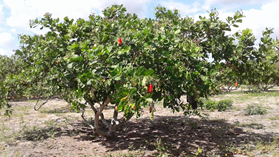Physical analysis of peduncles of dwarf cashew clones for consumption, processed or natural

Abstract
The physical characteristics of cashew-dwarf peduncles were evaluated to later indicate the best clones for natural consumption and/or processing, considering that consumers appreciate products for their visual attractiveness. The objective of this study was to analyze peduncles of dwarf cashew clones obtained from the Genetic Improvement Program of Embrapa Agroindústria Tropical, Cruz-CE experimental area, in order to make inferences about the physical characteristics and indicate the best clones for natural consumption and/or processing. The analyzed variables were: total mass of the cashew (MT), chestnut mass (MC), peduncle mass (MP), apical diameter (DA), basal diameter (DB), length and firmness. The experiment design was a randomized complete block design with 25 treatments (clones) with 3 replications and up to 12 cashews per plot (four plants in total). The analysis of variance and the comparison of the means by the Scott and Knott test was realized. When analyzing the MT values, it was found that 100% of the clones were classified as types 4 (approximately 150 g), 5 (approximately 100 g) and 6 (approximately 150 g) cashews/tray. As for MC, there was a variation from 8.18 to 15.08 g. General averages of 95.16, 50.07 and 41.38 mm were found for the variables length, DB and DA of peduncle, respectively. It is concluded that, in general, all clones presented good characteristics; however, clone 108-6 is the preference for most consumers since it has red staining, as did the control (CCP 76). Therefore, all clones presented desirable characteristics for natural consumption and/or processing.
Keywords
Anacardium occidentale L., Post-harvest quality, Clones, Production
References
Abreu, C.R.A. 2007. Qualidade e atividade antioxidante total de pedúnculos de clones comerciais de cajueiro anão precoce. MSc thesis. University Federal of Ceara, Fortaleza, Brazil.
Almeida, M., W. Freitas, J. Sarmento, P. Moarais, and G. Silva. 2011. Qualidade pós-colheita de pedúnculos de cajueiro submetido a dois métodos de colheita e mantidos sob refrigeração. Rev. Verde Agroecologia Desenvolv. Sustent. 6(3), 168-173.
Almeida, M.L.B., C.A.H. Moura, R. Inneco, and M.R.S. Silveira. 2018. Características físicas de pedúnculos de clones de cajueiro-anão (Anacardium occidentale L.) produzidos em função da variação ambiental e temporal. Rev. Colomb. Cienc. Hortic. 12(1), 41-49. Doi: 10.17584/rcch.2018v12i1.7509
Aular, J. and W. Natale. 2013. Nutrição mineral e qualidade do fruto de algumas frutíferas tropicais: goiabeira, mangueira, bananeira e mamoeiro. Rev. Bras. Frutic. 35(4), 1214-1231. Doi: 10.1590/S0100-29452013000400033
Banzatto, D.A. and S.N. Kronka. 2013. Experimentação agrícola. 4th ed. FUNEP, Jaboticabal, Brazil.
Gomes, J.C.M., N.W. Gomes, L.C.A. Silva, W.A. Lima, and J.M. Silva. 2006. Postharvest characterization of early dwarf cashew tree clones in Western Bahia. Bahía Agríc. 07(02), 76-80.
Lopes, M.M.A. 2011. Qualidade e atividade antioxidante total em pedúnculos de clones de cajueiros anão precoce em diferentes estádios de maturação. MSc thesis. Universidade Federal do Ceará, Fortaleza, Brazil.
Lopes, M.M.A., C.F.H. Moura, F.A.S. Aragão, T.G. Cardoso, and J. Enéas Filho. 2011. Caracterização física de pedúnculos de clones de cajueiro anão precoce em diferentes estádios de maturação. Rev. Ciênc. Agron. 42(4), 914-920. Doi: 10.1590/S1806-66902011000400013
Moura, C.F.H., R.E. Alves, R. Innecco, H.A.C. Filgueiras, J.L. Mosca, and S.A.A. Pinto. 2001. Características físicas de pedúnculos de cajueiro para comercialização in natura. Rev. Bras. Frutic. 23(03), 537-540. Doi: 10.1590/S0100-29452001000300017
Moura, C.F.H., R.E. Alves, E.O. Silva, and M.M.A. Lopes. 2015. Fisiologia e tecnologia pós-colheita do pedúnculo do cajueiro. 3th ed., revised and expanded. Embrapa Agroindústria Tropical, Fortaleza, Brazil.
Pereira, M.C.T., H.C.T. Correa, N.S. Silvia, W.F. Mota, and S.V. Marques. 2005. Caracterização físico-química de pedúnculos e castanhas de clones de cajueiro-anão precoce nas condições do norte de Minas Gerais. Bragantia 64(2), 169-175. Doi: 10.1590/S0006-87052005000200001
Wang, G.Y., X.Z. Zhang, Y. Wang, X.F. Xu, and Z.H. Han. 2015. Key minerals influencing apple quality in Chinese orchard identified by nutritional diagnosis of leaf and soil analysis. J. Integr. Agr. 14(5), 864-874. Doi: 10.1016/S2095-3119(14)60877-7
